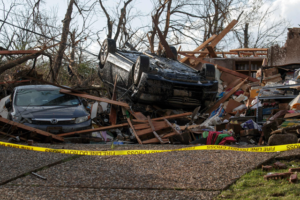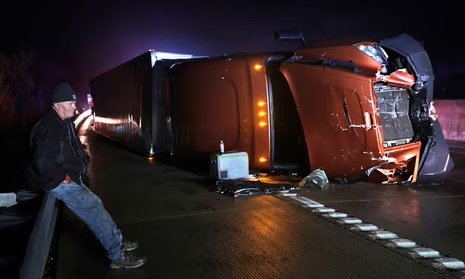Violent tornadoes that swept through parts of the U.S. on Saturday caused deadly destruction as the storms moved eastward into the Mississippi Valley and Deep South. At least 17 people were killed, and many homes were completely destroyed.
The most fatalities occurred in Missouri, where the state was struck by twisters overnight, resulting in at least 11 deaths. Missouri State Highway Patrol also reported several injuries.
Among the victims was a man who was killed when a tornado tore apart his home.
“It was unrecognizable as a home. Just a debris field,” said Butler County Coroner Jim Akers, describing the scene. “The floor was upside down. We were walking on walls.”
Rescuers managed to save a woman from the wreckage, Akers added.
In Arkansas, three people were confirmed dead, and 29 others were injured across eight counties after the storms passed through overnight.
“We have teams out surveying the damage from last night’s tornadoes, and first responders are on the ground to assist,” said Arkansas Governor Sarah Huckabee Sanders on social media.
Sanders and Georgia Governor Brian Kemp both declared states of emergency in their respective states in preparation for severe weather expected later in the day.
On Friday, three people were killed in car accidents caused by a dust storm in Amarillo, Texas.
The deaths come as a large storm system moved across the country, bringing with it powerful winds that triggered deadly dust storms and sparked more than 100 wildfires.
Extreme weather conditions—including hurricane-force winds—are expected to affect over 100 million people. Winds gusting up to 80 mph (130 kph) were predicted from the Canadian border to Texas, with blizzard conditions expected in northern areas and wildfire risks in warmer, drier regions to the south.
Evacuations were ordered in some Oklahoma communities as more than 130 fires were reported across the state.
Oklahoma Governor Kevin Stitt reported that nearly 300 homes had been damaged or destroyed by fires. He said that about 266 square miles (689 square kilometers) of land had burned so far in his state.
The strong winds also toppled several tractor-trailers. “This is terrible out here,” said Charles Daniel, a truck driver hauling a 48-foot trailer along Interstate 40 in western Oklahoma. “There’s a lot of sand and dirt in the air. I’m not going over 55 mph. I’m scared it will blow over if I do.”

Experts say that weather extremes like these are not unusual in March.
As the storms moved through, the Storm Prediction Center warned that fast-moving storms could generate tornadoes and hail the size of baseballs. However, the greatest danger was from powerful straight-line winds near or exceeding hurricane force, with gusts potentially reaching 100 mph (160 kph).
Significant tornadoes, some of which could be long-track and violent, were expected on Saturday afternoon and evening. The area at the highest risk stretched from eastern Louisiana and Mississippi in the afternoon, moving into Alabama, western Georgia, and the Florida Panhandle later in the day.
In addition to Oklahoma, wildfires spread across parts of the Southern Plains, fueled by dry, windy conditions in Texas, Kansas, Missouri, and New Mexico.

A fire in Roberts County, Texas, northeast of Amarillo, rapidly expanded from less than a square mile to an estimated 32.8 square miles (85 square kilometers), according to the Texas A&M University Forest Service. Crews were able to stop its spread by Friday evening.
About 60 miles (90 kilometers) south, another fire grew to 3.9 square miles (10 square kilometers) before its advance was halted.
High winds also caused widespread power outages, leaving more than 260,000 homes and businesses without electricity in Texas, Oklahoma, Arkansas, Missouri, Illinois, and Indiana, according to PowerOutage.us.
Blizzard warnings were issued for parts of far western Minnesota and eastern South Dakota. Snow accumulations of 3 to 6 inches (7.6 to 15.2 cm) were expected, with up to a foot (30 cm) in some areas. Winds gusting to 60 mph (97 kph) were expected to create whiteout conditions.










































